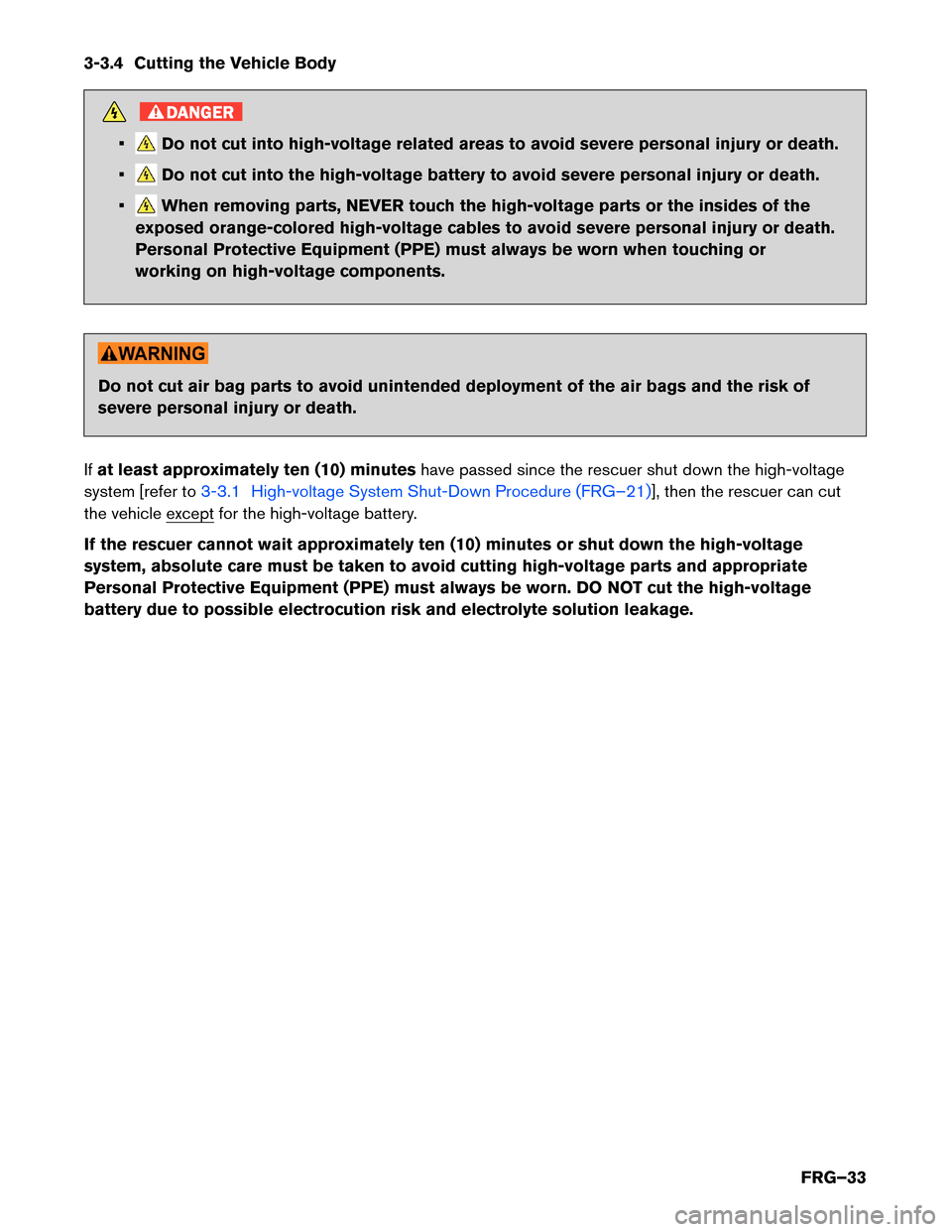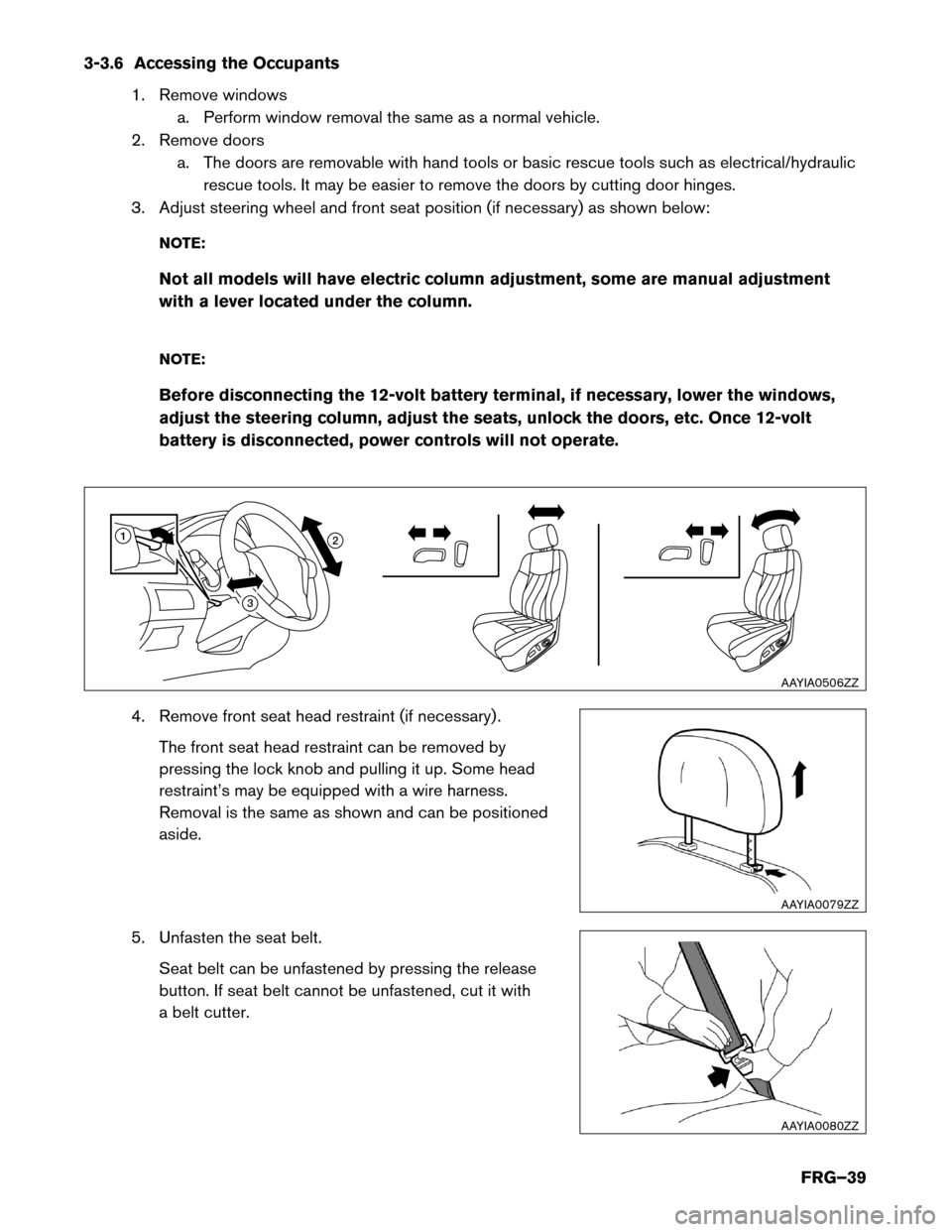Page 33 of 46

3-3.4 Cutting the Vehicle Body
DANGER
• Do not cut into high-voltage related areas to avoid severe personal injury or death.
• Do not cut into the high-voltage battery to avoid severe personal injury or death.
• When removing parts, NEVER touch the high-voltage parts or the insides of the
exposed orange-colored high-voltage cables to avoid severe personal injury or death.
Personal Protective Equipment (PPE) must always be worn when touching or
working on high-voltage components. Do not cut air bag parts to avoid unintended deployment of the air bags and the risk of
severe
personal injury or death.
If at least approximately ten (10) minutes have passed since the rescuer shut down the high-voltage
system [refer to 3-3.1 High-voltage System Shut-Down Procedure (FRG–21)], then the rescuer can cut
the
vehicle except for the high-voltage battery. If the rescuer cannot wait approximately ten (10) minutes or shut down the high-voltage
system,
absolute care must be taken to avoid cutting high-voltage parts and appropriate
Personal Protective Equipment (PPE) must always be worn. DO NOT cut the high-voltage
battery due to possible electrocution risk and electrolyte solution leakage.
FRG–33
Page 34 of 46
SRS Air Bag System Components Location
Avoid
cutting air bag system parts. However, the vehicle can be cut (except inflators) under the following
conditions: • The front, side and curtain air bags have deployed.
• At least three (3) minutes have passed after the 12-volt battery negative (-) cable has beendisconnected and the high-voltage system has been shut down. = Inflators (Peel back plastic trim parts prior to cutting operation to confirm exact inflator location.)
= Sensors
AAYIA0545ZZ
FRG–34
Page 35 of 46
1. Passenger supplemental front-
impact
air bag module 2. Air bag control unit (ACU) 3. Occupant classification system
control unit and sensors (weight
sensors – located on passenger
seat frame)
4. Front seat-mounted side-
impact supplemental air bags 5. Satellite sensors (rear) 6. Roof-mounted curtain side-
impact and rollover supplemental
air bag inflators
7. Crash zone sensor 8. Pressure sensor (passenger
side door) 9. Pressure sensor (driver side
door)
10. Driver supplemental front-
impact air bag module 11. Seat belts with pretensioners 12. Satellite sensors (front) AAYIA0546ZZ
FRG–35
Page 36 of 46
Vehicle Cut Sheet
AAYIA0547ZZ
FRG–36
Page 37 of 46
High Strength Steel Locations
= High strength steel
=
DANGER
AAYIA0505ZZ
FRG–37
Page 38 of 46

3-3.5 High-voltage Battery Damage and Fluid Leaks
The high-voltage battery contains electrolyte solution. To avoid exposure to electrolyte
solution
and serious personal injury, always wear appropriate solvent resistant Personal
Protective Equipment (PPE) and read the following precautions:
• Electrolyte solution is a skin irritant.
• Electrolyte solution is an eye irritant – If contact with eyes, rinse with plenty of water and see a doctor immediately.
• If electrolyte leak occurs, wear appropriate solvent resistant PPE and use a dry cloth to clean up the spilled electrolyte. Be sure to adequately ventilate the area.
• Electrolyte solution is highly flammable.
• Electrolyte liquid or fumes that have come into contact with water vapors in the air will create an oxidized substance. This substance may irritate skin and eyes. In these cases,
rinse with plenty of water and see a doctor immediately.
• Electrolyte fumes (when inhaled) can cause respiratory irritation and acute intoxication. Move to fresh air and wash mouth with water. See a doctor immediately.
If electrolyte solution leakage, or damage such as any problem with the high-voltage battery casing are
observed, first responders should attempt to neutralize the battery by applying a large volume of water to the
battery pack while wearing appropriate Personal Protective Equipment (PPE) . The neutralization process
helps stabilize the thermal condition of the battery pack but does not discharge the battery.
High-voltage Battery Electrolyte Solution Characteristics: • Clear in color
• Sweet odor
• Similar viscosity to water
• Since the high-voltage battery is made up of many small sealed battery modules, electrolyte solutionleakage should be minimal.
NOTE:
Other fluids in the vehicle (such as engine oil, washer fluid, brake fluid, coolant, etc.) are
the same as those in a conventional vehicle.
FRG–38
Page 39 of 46

3-3.6 Accessing the Occupants
1. Remove windowsa. Perform window removal the same as a normal vehicle.
2. Remove doors a. The doors are removable with hand tools or basic rescue tools such as electrical/hydraulicrescue tools. It may be easier to remove the doors by cutting door hinges.
3. Adjust steering wheel and front seat position (if necessary) as shown below:
NOTE:
Not all models will have electric column adjustment, some are manual adjustment
with a lever located under the column.
NOTE:
Before disconnecting the 12-volt battery terminal, if necessary, lower the windows,
adjust the steering column, adjust the seats, unlock the doors, etc. Once 12-volt
battery is disconnected, power controls will not operate.
4. Remove front seat head restraint (if necessary) . The front seat head restraint can be removed by
pressing the lock knob and pulling it up. Some head
restraint’s may be equipped with a wire harness.
Removal is the same as shown and can be positioned
aside.
5. Unfasten the seat belt. Seat belt can be unfastened by pressing the release
button. If seat belt cannot be unfastened, cut it with
a belt cutter. 21
3
AAYIA0506ZZ
AAYIA0079ZZ
AAYIA0080ZZ
FRG–39
Page 40 of 46
3-4 Storing The Vehicle
For
vehicle storage information, refer to Dismantling Guide located at www.nissanusa.comor
www.nissan-techinfo.com.
FRG–40